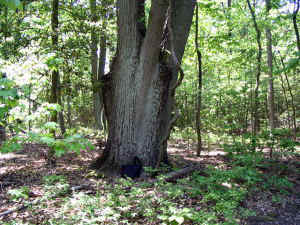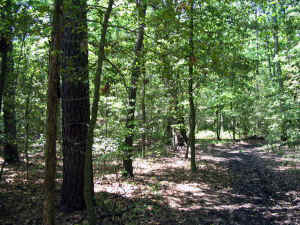Greetings, fellow ENTS!
I finally got the time to post the results of my measuring trip
to Downs
Memorial Park, a small county park located on the Chesapeake Bay
here in
central Maryland. While the trees are generally not of
astounding height
or girth considering the young age of the forest and its
proximity to
winds and storms that come in off the Bay, there are a very wide
variety
of trees represented here, including a few rather big ones.

|
| "Sweetgums on the Bay" shows some of the large
sweetgum trees that grown right down next to the Chesapeake Bay. These trees reach
a decent size and have amazingly survived several hurricanes that have
passed through the area, with Isabel back in 2003 being the most recent one
of significance.
|
Date: May 13, 2007
Location: Eco Trail heading towards the Bay
General Measuring Notes: All circumferences measured at 4.5
above the
ground. Heights are just estimates based on in part on what is
typical
for the species and are probably understated since Id rather
not make
claims for exceptional height that cannot be backed up with
numbers.
There was no effective way to measure the height of nearly all
of these
trees without a laser, which I do not have.
 |
| "Chestnut oak patriarch" is a picture of the huge,
14+' in girth chestnut oak I found along one of the trail. One can see my
water bottle and notebook bag on the ground in front of the tree to give a
sense of scale. Considering its size and the relatively young age of the park,
I suspect it was there before most of the rest of the forest grew back. |
1) Willow Oak cbh = 43 height estimate = 70+
2) White Oak (vines) cbh = 411 height estimate = 75+
3) White Oak cbh = 55 height estimate = 80+
4) White Oak cbh = 51 height estimate = 80+
5) White Oak cbh = 58 height estimate = 80+
6) Southern Red Oak cbh = 35 height estimate = 70+
7) Southern Red Oak cbh = 74 height estimate = 80+
8) Chestnut Oak (gnarly) cbh = 70 height estimate = 80+
9) Chestnut Oak cbh = 710 height estimate = 80+
10) Chestnut Oak cbh = 75 height estimate = 80+
11) Chestnut Oak (Patriarch tree) cbh = 146 height
estimate = 90+
(This tree is a giant and is considerably larger than any other
tree I
saw in the park. The tree does cheat a bit in that it has
a lot of low
branches about 6-feet above ground, but the massive trunk is a
single
trunk. This tree may have been here before the forest was
allowed to
regrow.)
12) Chestnut Oak (picnic tree) cbh = 99 height estimate =
80+
(Another one of the larger trees in the park. An even bigger
white or
chestnut oak stands nearby, but it has been dead for several
years.)
13) Loblolly Pine chb = 52 height estimate = 70+
14) American Holly cbh = 17 height estimate = 40+
15) Sweetgum cbh = 411 height estimate = 75+
16) Sweetgum cbh = 64 height estimate = 70+
(What is interesting about this tree is that it is part of a
grove of
sweetgums, all of similar size, that grow right near the Bay,
fully
exposed to the winds.)
17) Black gum cbh = 15 height estimate = 40+
18) Black gum cbh = 26 height estimate = 60+
19) American Chestnut cbh = 11 height estimate = 20+
(This measurement comes from the larger, dead trunk of a
blight-battered
American Chestnut. New stalks were sprouting, but they were much
smaller)
20) American Chestnut cbh = 110 height estimate = 60+
(This measures the living trunk of the labeled American Chestnut
with
little to no blight)
21) Tulip Tree cbh = 52 height estimate = 80+
(Tulip trees are quite uncommon in the park from what I have
seen..)
 |
| "Pine Tree" shows one of the loblolly pines
that grows in the park. They also reach a good size and are reasonably common
in some areas of the park. |
General tree notes: Park is heavily dominated by oak trees:
white oak,
chestnut oak, and southern red oak are the most common varieties
that I
have seen thus far. Smaller trees are commonly black gum or
sweet gum.
Both of them are very common, though large specimens are hard to
find.
Loblolly Pine can be found here and there throughout the park.
American
Holly is also reasonably common, as is sassafras. I also saw
some young
maples, but no older ones. Finally, in fall of 2006, I saw some
hickory
or pecan nuts on the ground not far from the marked American
Chestnut,
but I never located the trees. The park has a high diversity of
trees
considering its relatively small size and exposure to the
winds and
potential storms of the Chesapeake Bay.
|